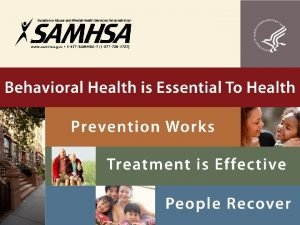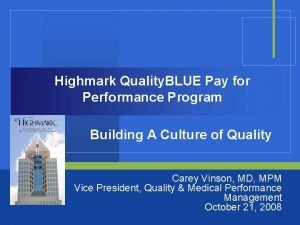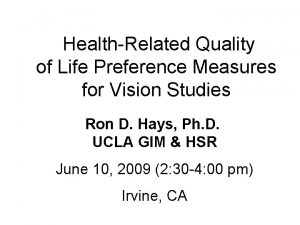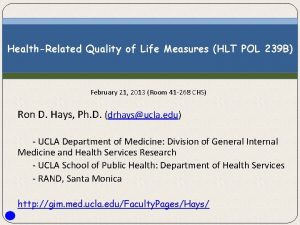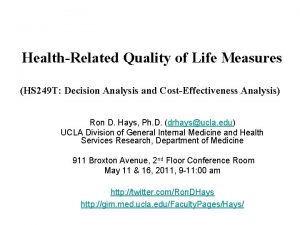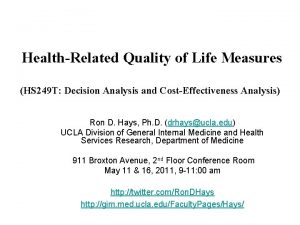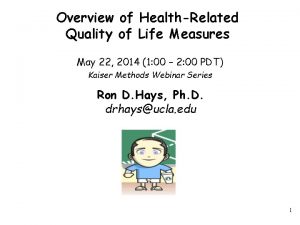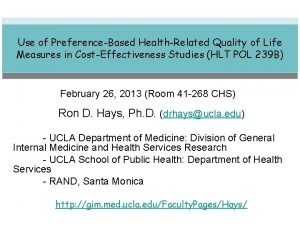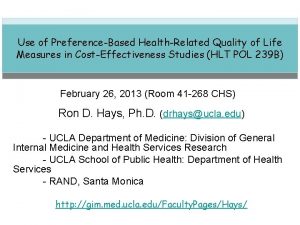HealthRelated Quality of Life Preference Measures for Vision
















- Slides: 16

Health-Related Quality of Life Preference Measures for Vision Studies Ron D. Hays, Ph. D. UCLA GIM & HSR June 10, 2009 (2: 30 -4: 00 pm) Irvine, CA

Sepi’s Charge 1) Pros versus cons of using generic versus disease-targeted measures to estimate preference scores/utilities 2) Example use of disease-targeted measure

Targeted Profile Measure - Designed to be relevant to subgroup. - Sensitive to small, important changes. - More familiar and actionable. • The next questions are about how things you do may be affected by your vision. For each one, please circle the number to indicate whether for you the statement is true for you all, most, some, a little, or none of the time. Do you accomplish less than y would like because of your vision?

Generic Profile Measure 1) Profile - Generic content and common scale - Multiple scores

Cost/utility requires QALY estimates Based on public preferences

Preference Measure - Direct (SG, TTO, Rating) - Underlying attributes not known - Indirect (EQ-5 D, QWB, SF-6 D, VFQ-UI) - Attributes known and used to estimate preferences Common scale


Why Estimate Preferences from Disease-targeted Measure? - Direct or other indirect preference measure not administered. - Indirect preference measure was administered but is insensitive to important aspects of HRQOL for given condition - e. g. , EQ-5 D not associated with VA or contrast sensitivity in persons with macular degeneration

Mobility Self-Care TTO Usual Activities VA Vision HRQOL EQ-5 D Pain Anxiety/Dep

Mapping Health States to Preference Score Exists Measured P 3, M 3 Perfect HRQOL 0. 9 P 2, M 3 0. 8 P 3, M 2 0. 7 P 3, M 1 0. 6 P 2, M 2 0. 5 P 1, M 3 P 2, M 1 0. 4 0. 3 P 1, M 2 P 1, M 1 0. 2 0. 1 Dead

Example Disease-Targeted Measure (VFQ-UI) 6. How much difficulty do you have doing work or hobbies that require you to see well up close, such as cooking, sewing, fixing things around the house, or using hand tools? 14. Because of your eyesight, how much difficulty do you have going out to see movies, plays, or sports events? 18. Are you limited in how long you can work or do other activities because of your vision? 25. I worry about doing things that will embarrass myself or others, because of my eyesight. 20. I stay home most of the time because of my eyesight. 11. Because of your eyesight, how much difficulty do you have seeing how people react to things you say? Near vision, distance vision, role function, mental health, dependency, social function

VFQ-UI - 6 item subset of NEI VFQ-25 (11 scales) - general vision, near vision, distance vision, driving, peripheral vision, color vision, ocular pain, role function, dependency, social function, mental health - 8 vision-related health states ranging from no difficulty to stopped doing work - TTOs from sample of 607 from Australia, Canada, U and U. S. ranged from 0. 34 -0. 96




Last Slide
 Repeated-measures design
Repeated-measures design Ccbhc quality measures
Ccbhc quality measures Highmarl true performance quality measures
Highmarl true performance quality measures Oncology care model two sided risk arrangement
Oncology care model two sided risk arrangement Cms oncology care model quality measures
Cms oncology care model quality measures Human vision vs computer vision
Human vision vs computer vision Quality assurance mission statement
Quality assurance mission statement Interim life safety measures examples
Interim life safety measures examples Quality assurance vs quality control
Quality assurance vs quality control Pmp quality management
Pmp quality management Pmbok quality management
Pmbok quality management Quality assurance model in nursing
Quality assurance model in nursing Quality improvement vs quality assurance
Quality improvement vs quality assurance Concepts of quality
Concepts of quality Management gurus and their contributions
Management gurus and their contributions Crosby's fourteen steps to quality improvement
Crosby's fourteen steps to quality improvement What is tqm
What is tqm

